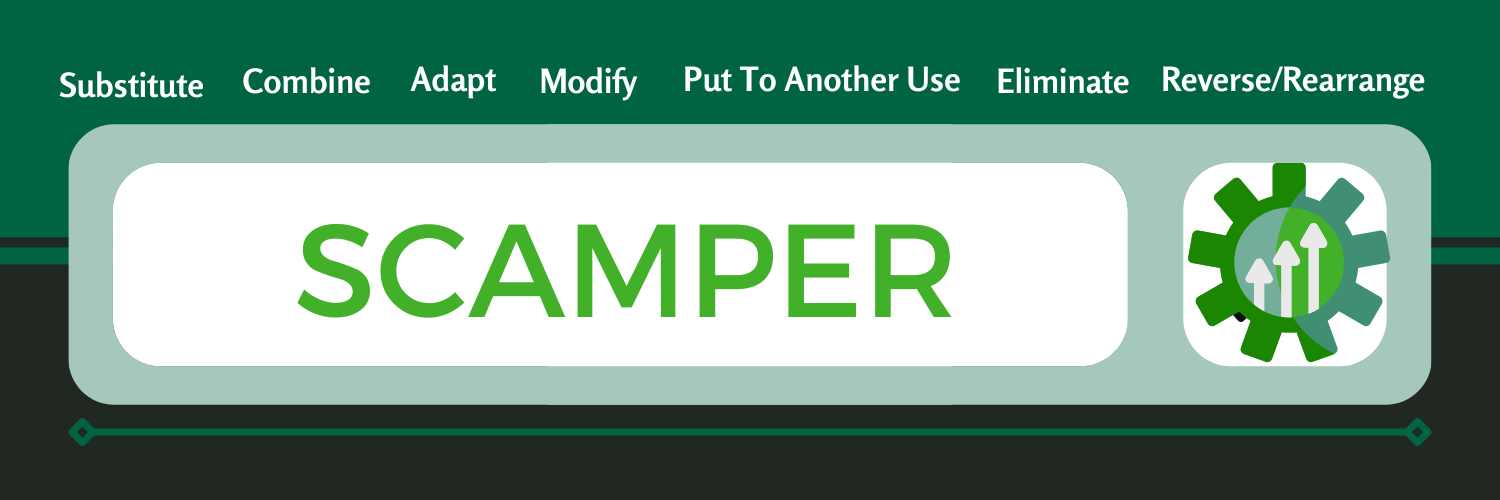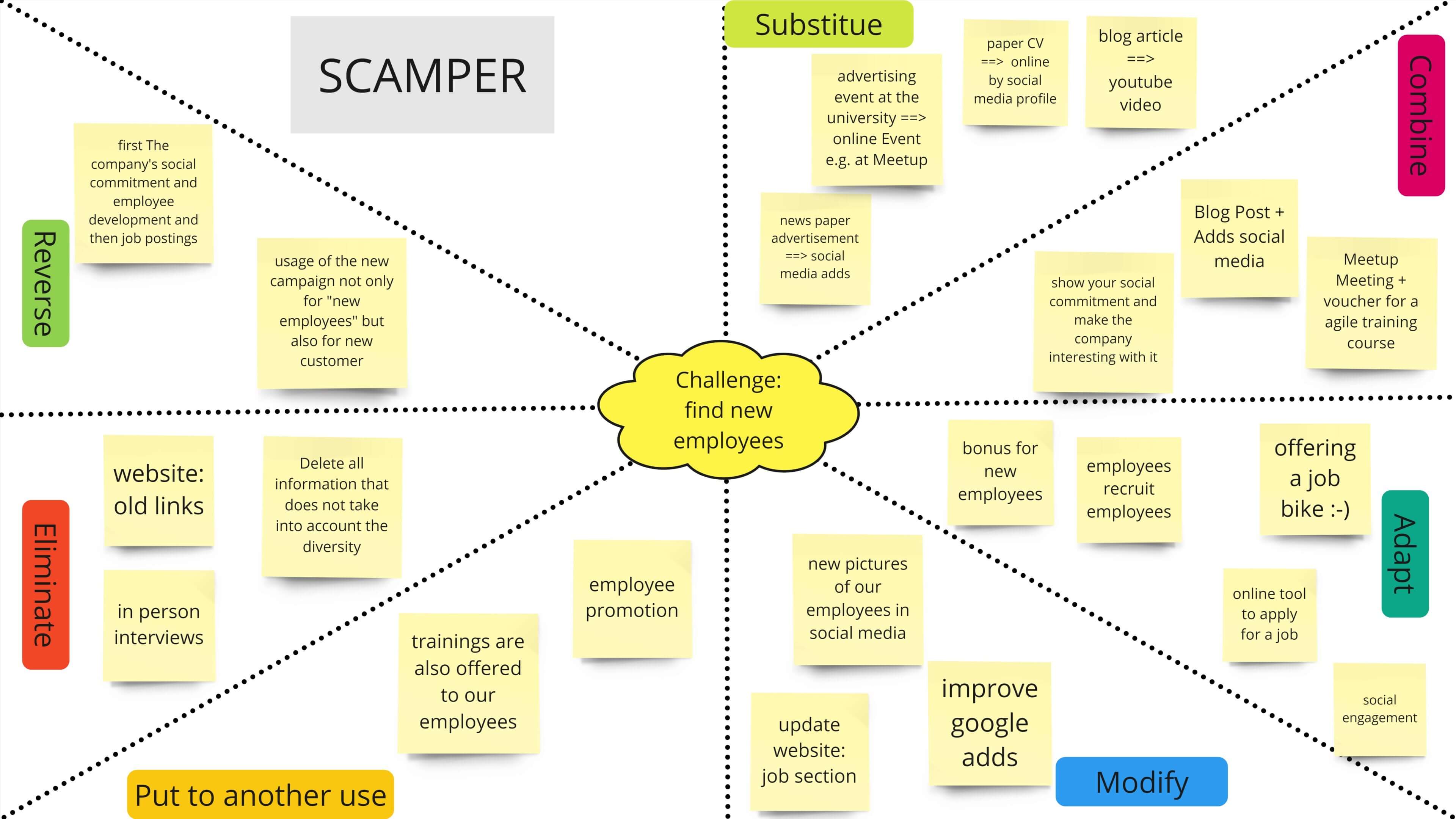AC Way Tool Highlight – SCAMPER
Posted on Friday, August 25th, 2023

So, you have a process you’d like to improve – maybe it works, and you just want it to be better, or maybe the current process leaves a lot to be desired. You’ve followed the DMAIC framework and defined the problem. Next you measured the process and analyzed the data available to you, and now you’d like to move to the next step – Improve.
But how do you make sure you get the best improvement ideas out of everyone?
This is where SCAMPER comes in
SCAMPER is a creative thinking technique used for continuous improvement and is a great way to spark innovative approaches to improving services and processes. Each letter in “SCAMPER” stands for a different prompt to stimulate ideas.
- Substitute
- Combine
- Adapt
- Modify/Magnify
- Put to another use
- Eliminate/Minimize
- Reverse/Rearrange
Here’s how you can use it:
- Substitute: Identify elements that can be substituted with something else. Ask yourself, “What if I replaced X with Y?” examples
| Original | Substitute |
| Plastic water bottles | Replace plastic with biodegradable materials like cornstarch for eco-friendly bottles |
| Taxi rides | Replace traditional taxis with ride-sharing services that use electric vehicles for a more sustainable transportation option |
| Traditional lectures | Replace lectures with interactive online modules that incorporate videos, quizzes, and discussions for better engagement. |
| In-person job interviews | Replace in-person interviews with video interviews to streamline the hiring process and reduce travel costs. |
- Combine: Think about how you can combine different elements or ideas to create something new. Ask, “What if I merged X and Y? What new possibilities could arise?”
| Original | Combination |
| Alarm clock + Coffee maker | Create an alarm clock that also brews a fresh cup of coffee to wake you up with the aroma. |
| Gym + Childcare | Introduce on-site childcare services at the gym, allowing parents to work out while their kids are supervised. |
| History class + Virtual reality | Combine history lessons with virtual reality experiences to allow students to “travel” to historical events and places. |
| Employee training + Gamification | Combine employee training programs with gamified elements to make learning more engaging and interactive. |
- Adapt: Consider how you can adapt an existing idea or process to better suit your needs. Ask, “How could I adapt X to solve this problem?”
| Original | Adaptation |
| Traditional light switch | Motion-sensor light switches that activate when someone enters a room to save energy. |
| Restaurant dining | Offer a virtual dining experience where customers can use augmented reality to “visit” the restaurant and interact with the menu before ordering online. |
| Learning Material: Textbooks | Transform textbooks into multimedia e-books that include animations, simulations, and interactive elements. |
| Fixed work hours | Implement flexible work hours or remote work options to accommodate different employee preferences and needs. |
- Modify/Magnify: Think about making changes or enhancements to an idea, process, or product. Ask, “How could I modify X to improve it? What if I increased or decreased certain aspects?”
| Original | Modification |
| Smartphone battery life | Increase smartphone battery life by using more energy-efficient components and software optimizations. |
| Fitness classes | Increase personalization by offering fitness classes tailored to specific health goals and individual abilities. |
| Note-taking | Introduce mind mapping techniques to help students visually organize and understand complex concepts. |
| Annual performance appraisals | Increase the frequency of performance feedback by conducting quarterly reviews to provide more timely guidance. |
- Put to another use: Explore alternative applications for an existing idea or product. Ask, “How else could I use X? What other purposes could it serve?”
| Original | Put To Another Use |
| Shipping containers | Repurpose shipping containers as affordable and modular housing units. |
| Food delivery service | Utilize the food delivery network to also deliver essential items like medication and groceries to seniors or individuals with limited mobility. |
| Classroom Tool: Whiteboards | Turn classroom whiteboards into collaborative problem-solving spaces where students can work together on projects. |
| Employee surveys | Use employee survey data from one area to identify other potential areas for innovation and improvements within the company. |
- Eliminate/Minimize: Identify elements that could be eliminated or minimized to streamline a process or improve an idea. Ask, “What if I removed X? How could I simplify this?”
| Original | Elimination |
| Restaurant menu with many options | Create a simplified menu with fewer dishes, focusing on quality rather than quantity. |
| Banking services with physical branches | Transition to fully online banking to reduce overhead costs and provide more convenient services to customers. |
| Standardized tests | Shift towards project-based assessments that focus on real-world problem-solving skills rather than memorization |
| Manual paperwork for onboarding | Transition to digital onboarding processes to reduce paperwork and save time for both HR and new hires. |
- Reverse/Rearrange: Consider reversing the order, direction, or arrangement of elements. Ask, “What if I did the opposite of X? How could I rearrange the components?”
| Original | Rearrangement |
| Traditional classroom layout | Arrange classroom furniture in a circle to encourage more interactive and collaborative learning. |
| Hotel check-in process | Implement self-check-in kiosks in hotel lobbies to expedite the check-in process and enhance guest experience. |
| Classroom Layout: Rows of desks facing the front | Arrange desks in small groups to encourage peer interaction and collaborative learning. |
| Team Structure: Hierarchical reporting | Implement cross-functional teams to encourage collaboration and idea-sharing across different departments. |
Bringing It All Together

Source – Miro
SCAMPER is a versatile tool, and these examples are just a starting point, and by systematically applying these prompts to your current processes, you can generate new insights and improvements. Remember to approach it with an open mind and be willing to explore unconventional ideas.
Please note that this tool is not for idea selection but for idea generation, so no idea is stupid and the more ideas the better.
Click here – SCAMPER Template to download a template.
Stay in the know!
Coming in Fall 2023, the AC Way team will be releasing our Intro to AC Way course, and our knowledge center will be going live Late Fall/Early Winter 2023! Stay tuned to the AC Way Blog for sneak peaks and launch announcements.
- Posted in
- AC Way Updates

